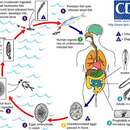en
names in breadcrumbs


Diphylobothrium latum was introduced to North America by immigrants from Scandinavia and has been spread greatly by domestic dogs that are fed raw fish. A severe broad tapeworm infection in humans is known to cause anemia due to the lack of vitamin B-12, which the tapeworm absorbs through the lining of the gut. The parasite can be avoided by thoroughly cooking fish and taking care when working with fish flesh.
Cestodes in general have sensory organs in the scolex, which are attached to longitudinal nerves extending down the body. The nerves are attached to organs and the cestodes can detect tactile stimulation.
Communication Channels: tactile
Perception Channels: tactile
Because of their potential harm to humans, efforts are being taken to prevent the spread of these worms.
CITES: no special status
The adults are hermaphroditic and capable of self- fertilization. Some are known to develop a second set of reproductive organs. Adults living in mammalian hosts produce eggs, which exit the host in fecal matter. Eggs may survive up to three years until conditions are right for development. The eggs are typically washed into freshwater lakes and streams where they are eaten by a copepod (Pappas, 1999). The coracidium larva, which hatches from the egg, is ciliated and bears six terminal hooks. The coracidium sheds its epithelium and furthur develops into the procercoid inside a copepod, the first intermediate host. Transformation into the fully infective procercoid takes several weeks to be completed (Roberts and Janovy, 2000). From there, the procercoid transfers hosts to a fish (such as trout) via ingestion of the copepod intermediate host. There it migrates to the flesh of the fish and further develops into the plerocercoid. The plerocercoid is characterized by a ribbon-like body with an undivided scolex. The plerocercoid may pass through other paratenic hosts until finally consumed by a mammalian definitive host (Roberts & Janovy, 2000). Mammals such as bears, dogs, and humans eat those fish and aquire the worms, which grow and reproduce in the host's intestines.
Diphyllobothrium latum has no positive effects on humans, but can be very harmful. Infestation (diphyllobothriasis) in humans can lead to anemia, due to depletion of vitamin B-12. Treatment for the anemia may be as simple as taking vitamin supplements. The worm must be irradicated medically, however, by the use of a drug called praziquantel (USFDA, 2001).
Negative Impacts: injures humans (causes disease in humans )
Ecosystem Impact: parasite
Species Used as Host:
This parasitic organism feeds on the contents of the host mammals' intestines through absorption. It has no gut or mouth, thus does not contain a complete digestive system. This tapeworm especially depletes the host of vitamin B-12, cleaving and sequestering almost all of the host's B-12. The worm may also interfere with the host's ability to take up the vitamin, thus supplements are needed to combat the deficiency (Roberts and Janovy, 2000; USFDA, 2001).
Animal Foods: body fluids
Primary Diet: carnivore (Eats body fluids)
This tapeworm is found in Palearctic and Nearctic areas: in the freshwater lakes and streams of North America and the Great Lakes, as well as the Mediterranean and Baltic Seas.
Biogeographic Regions: nearctic (Introduced ); palearctic
Diphyllobothrium latum is found in and around freshwater lakes and streams. Each stage inhabits a different habitat. The eggs inhabit fecal matter from the definitive host, the larvae live first in a copepod and then in the flesh of fish, and the adults inhabit mammalian intestines.
Habitat Regions: temperate ; freshwater
Terrestrial Biomes: forest
Aquatic Biomes: lakes and ponds; rivers and streams
Other Habitat Features: agricultural ; riparian
The adult Diphyllobothrium latum may reach up to 12 meters, increasing throughout its life. These whitish/yellow worms are dorso-ventrally flattened, and much more narrow than they are long. They have no oral opening, thus feeding through absorption. The finger-shaped scolex has no hooks, and narrow weakly-muscular grooves (bothria) run longitudinally along the body (scolex) (Roberts and Janovy, 2000).
Diphyllobothrium latum is hermaphroditic, carrying both sets of sex organs (Vergeer, 1932). In each proglottid, testes and vitelline follicles are found (Roberts and Janovy, 2000). The uterus is a bilobed structure that loops, extending from the ovary to the uterine pore on the midventral surface of the segment, through which the mature proglottids (the term for a complete set of sex organs) release the eggs. The eggs are continually produced (Swiderski, 2000). This species is anapolytic, meaning that they shed their proglottids after usage. The eggs are unembryonated and have a lid-like operculum (USFDA, 2001).
Range length: 12 (high) m.
Other Physical Features: ectothermic ; bilateral symmetry
The adults are hermaphroditic and capable of self- fertilization. Some are known to develop a second set of reproductive organs. Adults living in mammalian hosts grow and reproduce in the host's intestinges. The eggs exit the host in fecal matter.
Key Reproductive Features: simultaneous hermaphrodite; sexual
Parental Investment: no parental involvement